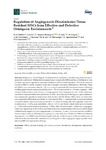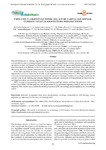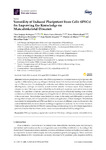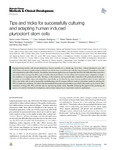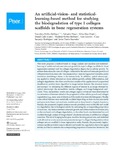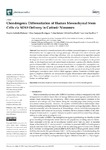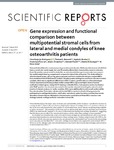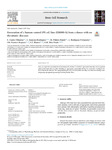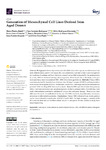Buscar
Mostrando ítems 1-10 de 19
Regulation of Angiogenesis Discriminates Tissue Resident MSCs from Effective and Defective Osteogenic Environments
(MDPI, 2020-05-28)
[Abstract] Background: The biological mechanisms that contribute to atrophic long bone non-union
are poorly understood. Multipotential mesenchymal stromal cells (MSCs) are key contributors to bone
formation and are ...
Immortalizing mesenchymal stromal cells from aged donors while keeping their essential features
(Hindawi, 2020-06-16)
[Abstract] Human bone marrow-derived mesenchymal stromal cells (MSCs) obtained from aged patients are prone to senesce and diminish their differentiation potential, therefore limiting their usefulness for osteochondral ...
Induced pluripotent stem cells for cartilage repair: current status and future perspectives
(AO Research Institute Davos, 2018-09-11)
[Abstract] The establishment of cartilage regenerative medicine is an important clinical issue, but the search for cell sources able to restore cartilage integrity proves to be challenging. Human mesenchymal stromal cells ...
Versatility of Induced Pluripotent Stem Cells (iPSCs) for Improving the Knowledge on Musculoskeletal Diseases
(MDPI, 2020-08-25)
[Abstract]
Induced pluripotent stem cells (iPSCs) represent an unlimited source of pluripotent cells
capable of di erentiating into any cell type of the body. Several studies have demonstrated the valuable
use of iPSCs ...
Tips and Tricks for Successfully Culturing and Adapting Human Induced Pluripotent Stem Cells [Protocol]
(Cell Press, 2021-12)
[Abstract] Reprogramming somatic cells toward pluripotency became possible over a decade ago. Since then, induced pluripotent stem cells (iPSCs) have served as a versatile and powerful tool not only for basic research but ...
An artificial-vision- and statistical-learning-based method for studying the biodegradation of type I collagen scaffolds in bone regeneration systems
(PeerJ, 2019-07-05)
[Abstract]
This work proposes a method based on image analysis and machine and statistical learning to model and estimate osteocyte growth (in type I collagen scaffolds for bone regeneration systems) and the collagen ...
Chondrogenic differentiation of human mesenchymal stem cells via SOX9 delivery in cationic niosomes
(MDPI, 2022-10-28)
[Abstract] Gene transfer to mesenchymal stem cells constitutes a powerful approach to promote their differentiation into the appropriate cartilage phenotype. Although viral vectors represent gold standard vehicles, because ...
Gene expression and functional comparison between multipotential stromal cells from lateral and medial condyles of knee osteoarthritis patients
(Nature Publishing Group, 2019-06-29)
[Abstract] Osteoarthritis (OA) is the most common degenerative joint disorder. Multipotential stromal cells (MSCs) have a crucial role in joint repair, but how OA severity affects their characteristics remains unknown. ...
Generation of a human control iPS cell line (ESi080‐A) from a donor with no rheumatic diseases
(Elsevier, 2020-03)
[Abstract]
Here, we report the establishment of the human iPS cell line N1-FiPS4F#7 generated from skin cells of a patient with no rheumatic diseases, thus obtaining an appropriate control iPS cell line for researchers ...
Generation of Mesenchymal Cell Lines Derived from Aged Donors
(MDPI, 2021-10-01)
[Abstract] Background: Mesenchymal stromal cells (MSCs) have the capacity for self-renewal and multi-differentiation, and for this reason they are considered a potential cellular source in regenerative medicine of cartilage ...


